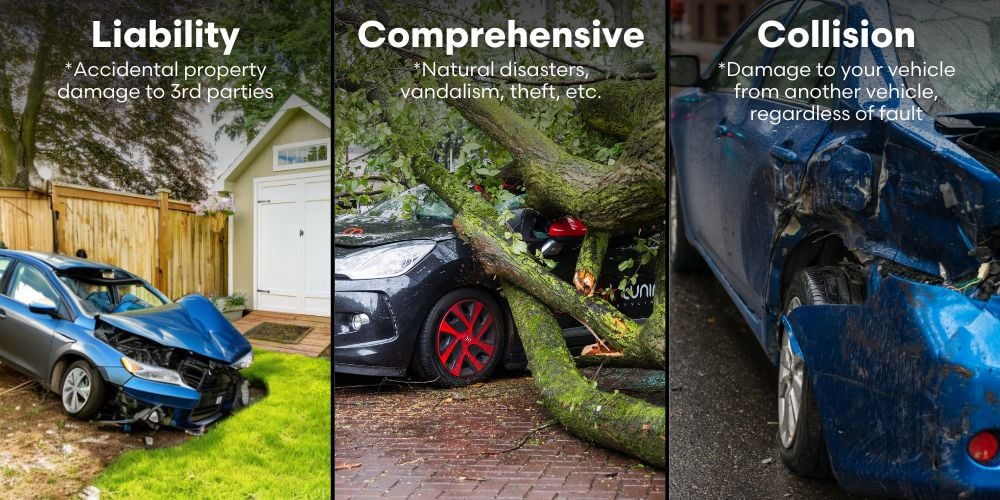Whenever you're getting any kind of insurance, the agent or broker will ask you a plethora of questions. Once the agent or broker has gotten the answers they need, they will come back to you with the different coverage options available and the price that those coverage options will cost you. You may have wondered, what truly goes into a car insurance premium?
The short answer is fairly simple: risk. Insurance providers assess:
- The level of risk
- The possible financial outcomes for that risk
- And the statistical likelihood of that situation occurring
From your risk assessment, an annual or monthly premium is calculated.
The logical next question becomes, what is risk and how do we calculate one risk over another? This question is far more complicated. Each insurance provider has risk factors that they assess and calculate towards an insurance premium.
Some of the factors that go into an auto insurance premium:
- Driving history
- Insurance history
- Credit history
- Value of the vehicle
- Repair cost of the vehicle
- Coverage and deductibles
- Location
- Commute distance
*Risk indicators and weighting vary by company.
Driving History
Your driving history can be broken into two main components:
- Number of years driving
- Number of driving convictions
Younger and new drivers are more likely to be in an accident. More experienced drivers are less likely to cause accidents, thus they reap the rewards of lower insurance premiums. Your auto insurance grid rating determines the maximum price one can pay for basic liability car insurance. Younger/newer drivers have a higher grid rate, which will result in them starting out with higher car insurance premiums. New drivers can take an accredited driver's training program to get the equivalent of two years of accident-free driving added to their record.
Driving convictions are tickets where you were pulled over by the police. It's important to note that only convictions related to your driving performance will impact your insurance premiums. Tickets for not having your vehicle registered, your vehicle is too loud, burned-out lights, or other non-performance-based tickets won't impact your car insurance premium. Additionally, photo radar and other camera tickets do not impact your car insurance because they cannot indicate who the driver is.

Tickets for your driving performance will impact your insurance premium for three years, from the conviction date (the date you pay the ticket). Some small food for thought: distracted driving tickets are considered a major conviction, which can increase your auto insurance premium by 25% or greater.
The better your driving history, the better your insurance rates.
Insurance History
Car insurance companies look at your insurance history for the previous six years when assessing your risk. They will look at your claims experience over that time frame and determine your risk for making a claim. With the DCPD system in Alberta, only at-fault claims will impact your insurance. If your insurance company has paid out a not-at-fault claim, it will not impact your insurance premium.
At-fault claims can increase your insurance premiums substantially, depending on your insurance company. The actual increase varies from as low as 30% up to 150% for a single at-fault accident.

Another element of insurance history is how long you've been continuously insured. If you're coming from out of province or out of the country, it's a good idea to get a claims experience letter from your prior jurisdiction's insurance company. Having a short insurance history or an insurance history with gaps may be associated with a higher risk.
It can also make a difference how long you've been with the same insurance provider. If you've been with the same insurance provider for a substantial period, you may be eligible for discounts or exclusive programs. If you've been with a provider for a long time, they may be more inclined to support you through extenuating circumstances.
Credit History
Your credit history can have a considerable impact on your auto insurance premium. Note, you are not required to give consent to a credit check before getting an auto insurance quote. That being said, soft credit checks done by insurance companies have no impact on your credit score.
Having good credit and a credit check can minimize the risk of the insurance company not getting paid the premium. If the insurance company is confident that you'll pay your auto insurance premiums, you're likely to get better rates on your car insurance and qualify for monthly payment plans. Again, you are not required to get a credit check to acquire insurance. However, without a credit check, the insurance company is less confident that you'll be able to pay your premiums. This can limit access to monthly payment plans and result in higher insurance costs.
Having a credit check with a good credit history can save you 10% to 25% on your car insurance premiums.
Value of the Vehicle
Since the introduction of DCPD (Direct Compensation for Property Damage) in Alberta, vehicle value plays a more substantial role in a car insurance premium. With DCPD, if you're in an accident with someone else and you were not at fault, you would still go through your own insurance company to pay the claim. While not-at-fault claims don't impact your insurance premiums, the value of your vehicle can impact the cost.
Your insurance company knows that if your car is damaged, regardless of fault, they will be responsible for paying for the damages. Higher value vehicles like Porsche, BMW, and Mercedes are often subject to more expensive auto insurance due to their higher replacement value.
Repair Cost of the Vehicle
Similarly to vehicle value, the repair cost of the vehicle is a considerable factor in auto insurance premiums. Tesla's are a prime example of vehicles with a high repair cost. With limited Tesla-certified repair stations, the cost of repairing a Tesla is considerably more expensive than other vehicles in the same class. Porsche has a similar repair cost to a Tesla.

It is important to note that many vehicles that have high repair costs are not necessarily high-value vehicles. Some of the most notorious culprits are Volkswagen vehicles. A combination of expensive replacement parts, complicated systems, and a limited number of repair technicians able to work on Volkswagen vehicles can result in very expensive repair bills. Those high repair costs may be reflected in your car insurance premium. Before you purchase a new vehicle, you can ask your broker to run a quote on the vehicle to get an idea of what the premiums will cost.
Insurance companies also factor in your vehicle's make and model into the premium based on auto theft. Companies will record vehicles that are considered high theft, and they will usually result in higher car insurance premiums. Imported or right-hand-drive vehicles are often high-theft vehicles, which may result in higher premiums and limited coverage options.
Type of Coverage and Deductibles
The three main types of auto insurance coverage are:
- Liability (damage to other people's property)
- Comprehensive (covers fire, theft, vandalism, natural disasters, and collisions with animals)
- Collision (covers the repair or replacement cost of your vehicle)

Basic liability insurance is the least expensive option and is the only insurance legally required to drive in Alberta. Comprehensive and collision coverage offer coverage for more situations, but they also come with a higher premium. Note that if you are financing a vehicle, you are required to carry full collision and comprehensive car insurance. Having a financed vehicle can make your insurance considerably more expensive.
Outside of the standard three coverages, you can also get added endorsements that offer additional protection. Endorsements vary by company, but here are a few:
- Replacement cost endorsement (replaces the full value of new vehicles in the event of a loss)
- Waiver of depreciation (limits depreciation in the event of a total loss)
- Family protection endorsement (protects from uninsured or underinsured motorists in an accident)
- Loss of use (covers the cost of a rental car)
- Claims forgiveness (covers a one-time at-fault claim without increasing your insurance)
Endorsements are not always automatically applied to your auto insurance policy and may not be available based on your driving record or the insuring company. Talk to your broker about endorsements available on your auto insurance policy.
Your car insurance deductible also plays a role in the policy premium. You will only pay a deductible on collision and comprehensive claims. Depending on the company, your deductible can range from as low as $250 all the way up to $25,000. Most deductibles are between $500 and $2,500 per claim.
Typically, the higher the deductible, the lower your monthly premium. Note that the difference between a $1,000 deductible and a $25,000 deductible is usually a difference of $10 to $20 per month. It's important to ensure you have a deductible that you can afford and that makes sense for your vehicle's value. Carrying a $25,000 deductible on a vehicle that is only worth $20,000 would not be a very wise decision.
If you have a high-value vehicle (over $100,000), insurers may require an even higher deductible. This usually starts at $5,000 and can reach $10,000 or more.

Location
The area that you live in can have a substantial impact on your car insurance. Major cities like Edmonton and Calgary are more likely to have a claim. More drivers on the road, more hit and runs, and a greater chance of theft all factor into a car insurance premium. Edmonton averages 30 hit-and-run reports every day, which equates to nearly 11,000 annually. Calgary happens to be the Canadian epicenter for hailstorms in Canada, which can cause millions in claims every year.
If you live in a surrounding area, town, or city, you're likely to experience lower auto insurance premiums than those in major metropolitan areas. Rural areas tend to get some of the lowest rates for auto insurance as their risk of making a claim is considerably lower.
Why does car insurance cost more in Alberta?
One of the reasons that Alberta auto insurance is higher than in other Canadian provinces is the legislation around personal injury law. Alberta does not currently have a cap on personal injury suits, which has led to an explosion of personal injury lawyers in Alberta. Personal injury claims have increased in Alberta, resulting in greater claims against insurance companies. Without a regulated maximum for personal injury claims, insurance companies have been paying out massive settlements. This has led to higher auto insurance premiums for all Albertans.
Commute Distance
Your daily and annual commute can be an impactful indicator of risk. Drivers who spend less time on the road are statistically less likely to be in an accident, which can result in lower car insurance premiums. In Alberta, a 40 km daily commute or 14,000 km to 20,000 km annually is a fairly average commute distance.
If you're driving 250 km each way to get to your workplace five days a week, you're going to be rated as a higher risk than someone who drives to the grocery store 2 km once a week.
Conclusion
Auto insurance has numerous factors that weigh into an auto insurance premium. The eight mentioned above are some of the most commonly assessed criteria. That being said, every insurance company weighs factors differently. What may be a significant factor for one company may have very little impact for another. All companies use their own metrics and analytics to determine risk factors.
Alberta car insurance can get complicated quickly. With all of the different risk factors, coverages, deductibles, and policy wordings, getting the coverage you need at the price you deserve can be challenging. When you work with a broker like Armour Insurance, you're working with an expert that is advocating for you to get the best coverage at the best price. We have the expertise on the products and the relationships with the companies to make your insurance buying experience painless.







